You may be wondering what possessed me to review twenty-one Wonder Boy games all at the same time. I certainly am! I did get a bit of a head-start though because the release of this Wonder Boy Anniversary Collection comes only a fraction over six months after the original Wonder Boy Collection, a digital release containing Wonder Boy, Wonder Boy in Monster Land, Wonder Boy in Monster World and Monster World IV, which we also reviewed here. And if I remember rightly, there was a physical version from Strictly Limited Games at the same time that was also called The Wonder Boy Anniversary Collection and also collected these games plus Wonder Boy III: Monster Lair and Wonder Boy: The Dragon’s Trap. And I think those six games make up the base games here, one way or another, once we consider the arcade and console variants included for each, but while that does make our task slightly less daunting, I’m fairly certain that by the time we’re done we’ll be so confused by Wonder Boy’s insane naming conventions that we probably won’t know if I’m right one way or the other, and we definitely won’t care! By the way, I did go through that minefield once already when I looked at the original Wonder Boy here, and I’ve no intention of ever doing it again, but what I will do is try and order this lot somehow so we’ve got each base game broken down into a look at all the variants for all the versions and platforms no matter what weird names they’ve got! And if you’re new to Wonder Boy, don’t worry, the madness I’m talking about will become clear by the time we’re even halfway through the first title!
You may also be wondering what possessed ININ and Bliss Brain to release a compilation of twenty-one Wonder Boy games, and even more so who would want it, but that’s what we’ll try and establish here shortly! The anniversary in the title refers to thirty-five years of Wonder Boy, which would actually have been in 2021, but let’s not be pedantic when we’re getting all this stuff here! Which reminds me, I’d like to mention that I was kindly provided with a review copy for Nintendo Switch by the publisher, it came out on 26th January 2023, and is also available for PlayStation, and on Switch at least it will set you back a whopping £45. I also want to mention that this collection was also not only under review embargo until the release date (which always cracks me up for stuff that’s been around for the best part of four decades now!) but the review codes also weren’t active until then, hence the short delay between first downloading it and it first appearing here while I played through twenty-one games! And obviously, I wasn’t playing twenty-one games to completion for this review, although I have completed almost all of the six base games in some capacity at some time or another so will focus more on the variations we’re presented with here. And with all caveats and disclaimers now in place, let’s talk presentation!
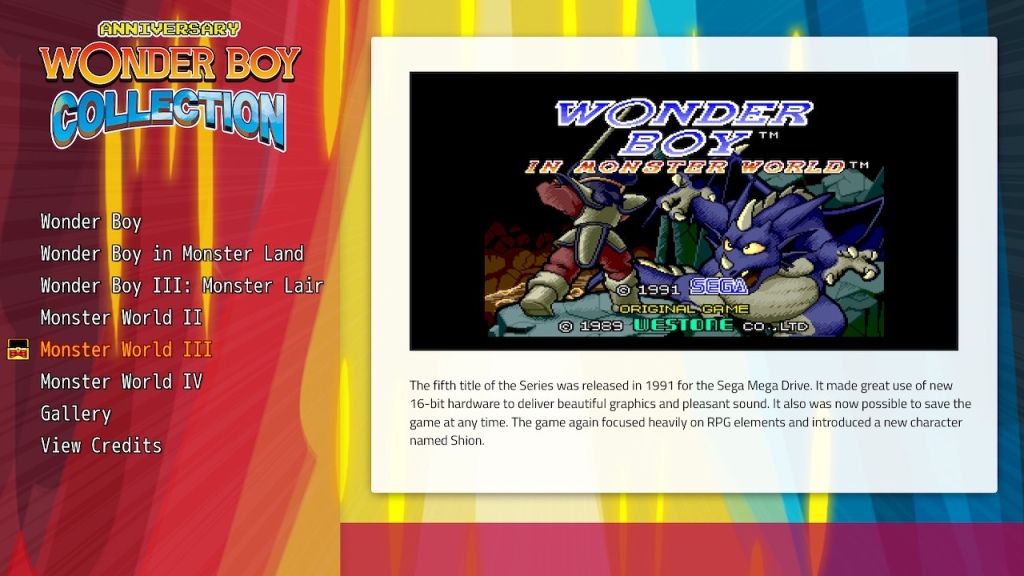
Once you’re past the language select screen, which is very pretty but I really don’t need to see every time I play, you’ve got a menu with each of the six base games, together with a big image of their title screen (which are variably interesting) plus the Gallery where all the extras are hiding. Before we look at those though, quick mention of the very Charlie Brown bit of orchestral laidback lounge jazz playing over the top of all these functional rather than remotely pleasing menus – not sure which game (if any) it’s from but it’s alright! I’ve got more to say on the “soundtrack” once we get there in the Gallery in a second, but first, clicking on that in the menu then brings up another list of the six games as well as one for this collection itself. While there’s certainly a lot to look through, there’s not as much as all these menus and sub-menus might imply; for example, the collection menu gives us Artbook and Soundtrack, which both bring up further menus, then twelve more specific items such as Boy, Asha and Landscape. Click on one and it brings up a gallery relating to that item, but you’ll soon realise the next item in the gallery is also the next item on the menu!
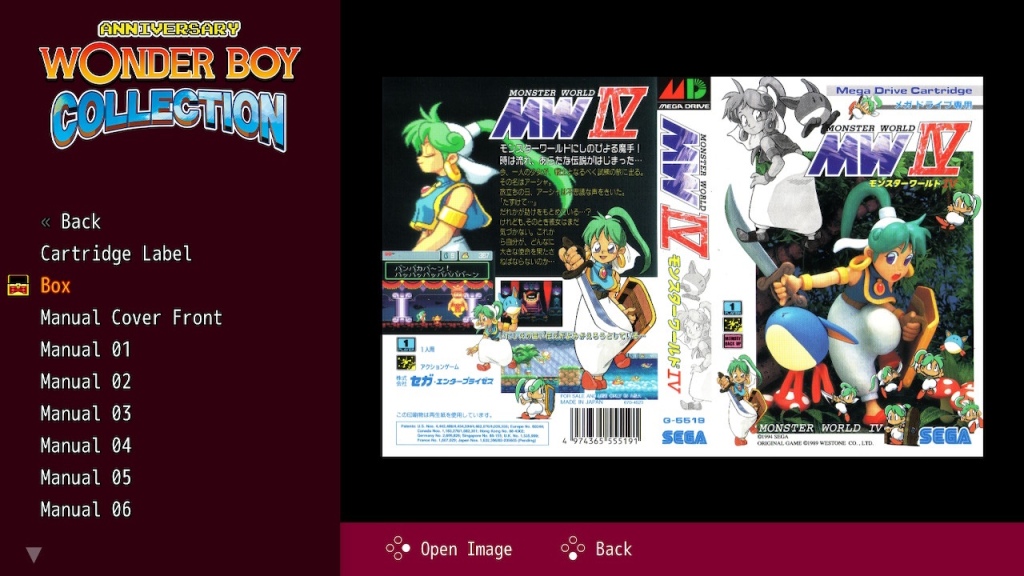
Similarly, the Artbook brings up a list of six further “Artbooks” but in reality it’s just a gallery of six images that you can either scroll through or select individually in the menu. Not the end of the world but Soundtrack really annoyed me though – I got all excited when I saw all the games listed here, thinking I was going to get to listen to them to my heart’s content in the kind of embedded music player that’s now familiar in many collections of this type, but no, it’s just another gallery (or menu) of images – no explanation either but I guess from the shape they’re CD cover images or something. Boo! Also “Boo!” when you start browsing through the individual game stuff – “Aacade Flyer” in 2023? Really? The rest is great though! For every version of every game included you’ve got front and back box art, full manuals, illustrations, then, where applicable, cartridge labels, flyers, magazine adverts and development material too. Tons to sift through, zoom into and enjoy. Which I did!

Back to the games themselves, once you’ve clicked on one proper you’re then presented with a list of the versions available, another title screen image and a nice paragraph on the game and its history, which I’ll no doubt be stealing from very shortly! From there, we’re just one more click from actually playing a game, but as well as that, we can also now load save states, adjust controls, set rewind speed, change display ratios, wallpapers, filters and the most comprehensive set of manual scanline settings you could ever imagine! There’s also a cool setting to use newly enhanced controls, like having a dedicated run button where the original controller might not have been able to offer one. Only slight complaint here is the original screen ratio seems to have been stretched just a little bit by default but honestly unless I’d been digging around I’d never have known! One last extra before we set off on our twenty-one game odyssey – every game has a full set of maps that you can easily access while you’re playing, and while it’s little more than a curio for the first game, by the time you get to Monster World IV there’s a few areas where you’ll be tearing your hair out without one! And with that, let’s check out the games in action…
WONDER BOY
Wonder Boy – International / Western – Arcade (SYSTEM 1)
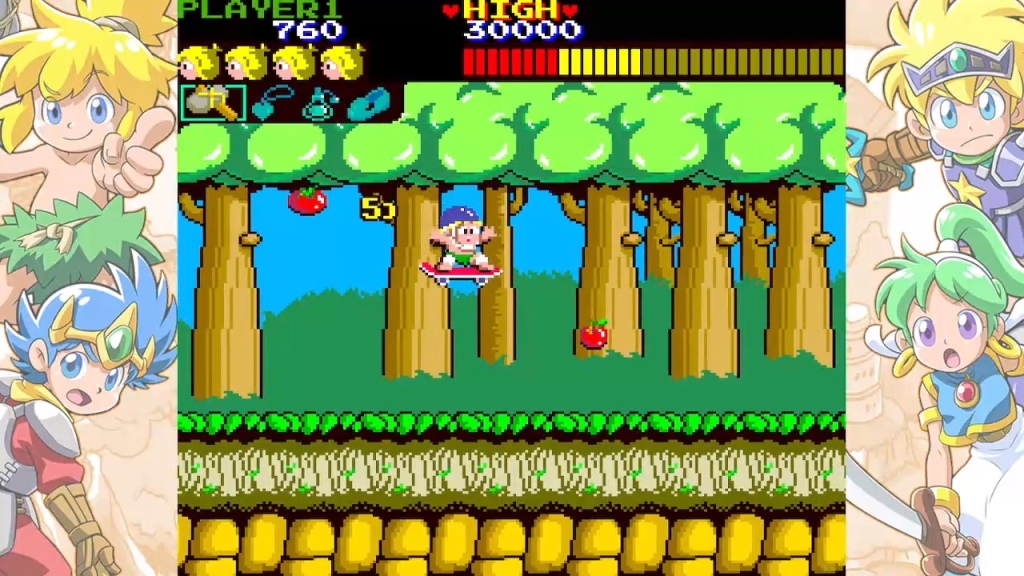
It’s 1986 and it’s a side-scrolling platformer from Sega, set somewhere between the pioneering addictiveness of Pac-Land and the sophistication of Super Mario Bros. Wonder Boy’s girlfriend (currently called Tina although that’s another can of worms I intend to avoid!) has been locked up by the evil Dark King so you’ve got to make your way through seven stages made up of four areas each to free her. Along the way you’ll find stone axes, a skateboard and an invincibility fairy to help, as well as loads of food to pick up to keep your energy topped up in the face of all the meanies you encounter. There’s also a doll tucked away somewhere in each level that not only doubles up bonus points at the end but collect all twenty-eight and you’ll unlock an eighth bonus stage! Surviving to anywhere near there will take some doing however many dolls you collect though, but along the way there’s quite the compelling high-score loop that will, apparently, keep you coming back for decades! I love this game and I don’t think I’ve ever been quite so attuned to a set of controls as I am here. And a delightful soundtrack and the happiest, brightest, boldest cartoon graphics you could ever hope for on top make this pretty much perfect as far as I’m concerned. Which means the next twenty games have got quite a lot to live up to!
Wonder Boy – Japanese – SG-1000
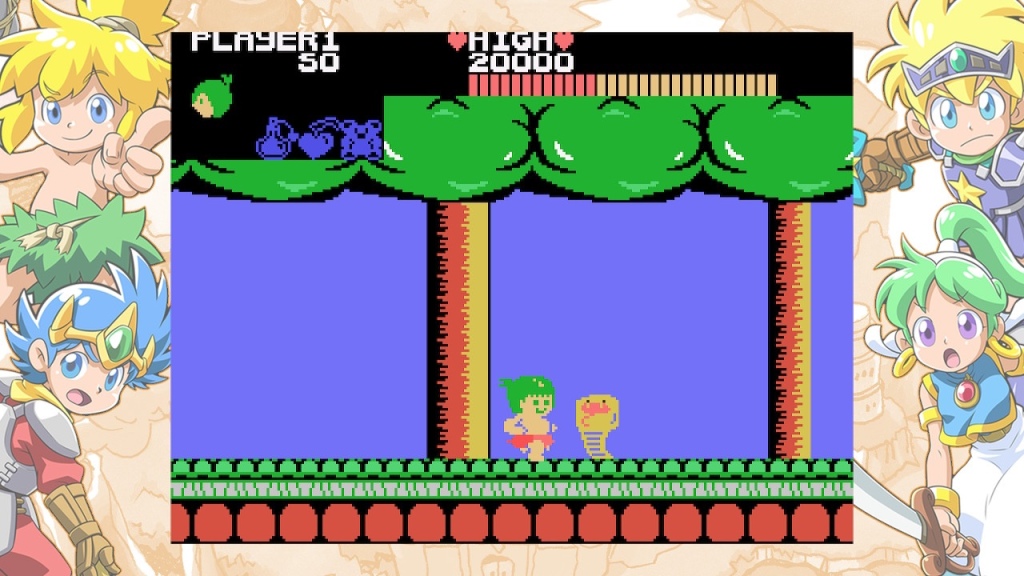
I was pretty excited about playing this one because I’ve never played anything on Sega’s first 8-bit console before! Sadly, that excitement evaporated within about five seconds of my first game. On the plus side, it controls alright. That’s all I’ve got though! And actually, the controls mean nothing when you can’t play at pace, which is what Wonder Boy is all about – first thing you notice, it looks like a ZX Spectrum game minus the colour clash and it scrolls like a dog. It’s horrendous. Like the music. Unfortunately what you won’t notice is the enemies popping in at the last second before you can properly react. Then there’s the unpredictability of things like rocks, that act like a trampoline but stop all horizontal motion dead at the same time. Or the instant game over at the first touch from the first stage boss! I could go on but we’re only on game two of twenty-one. It’s a rough approximation of Wonder Boy. With the emphasis on rough.
Super Wonder Boy – Japanese – Master System / Sega MARK III

As I said at the start, I’m not going into naming conventions again here or ever again, but just be aware that this is where it all begins! Apart from that, this is more like it! I’ve played a fair bit of Master System Wonder Boy over the years, which I believe is basically lifted straight from the arcade hardware, so you really couldn’t ask for more of a conversion… But that’s exactly what you’re getting! Two more areas on top of the original’s seven, in fact! It plays fast and the controls, while possibly lacking a bit of the finesse of the original (and possibly just down to designed for pad versus stick) feel good once you’ve adjusted. There are a few simplifications but forget those because nearly arcade-perfect in 1987 plus all those extra levels make that totally meaningless!
Wonder Boy – International / Western – Master System / Sega MARK III
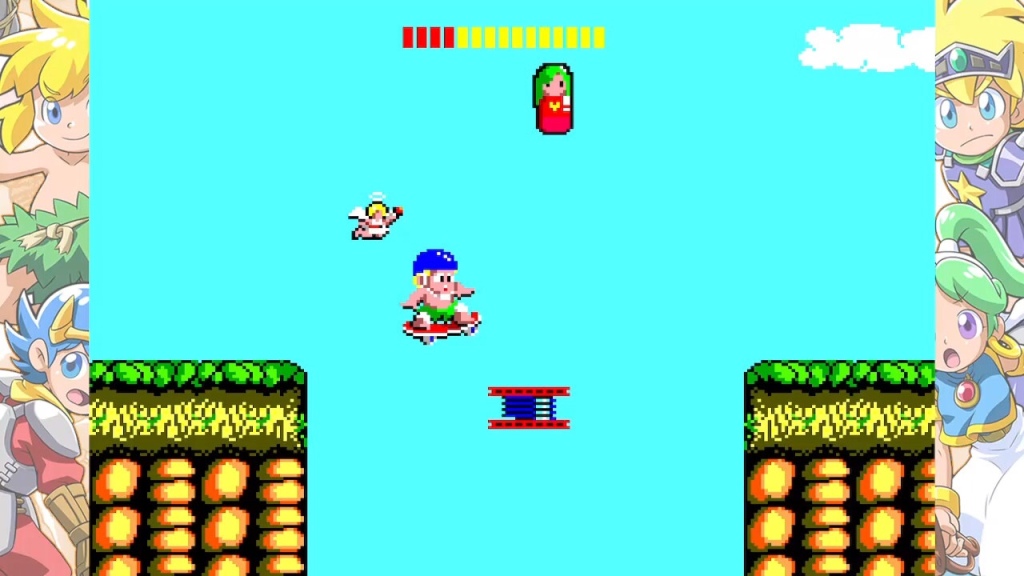
Well, it’s called Wonder Boy again, but apart from that I genuinely can’t tell the difference between this and the last version – I can’t even reference more enlightened original Japanese text or funny translations. And therein lies what I’m predicting is going to be my main problem with this collection as a whole. Let’s see…
Wonder Boy – Japanese – Game Gear
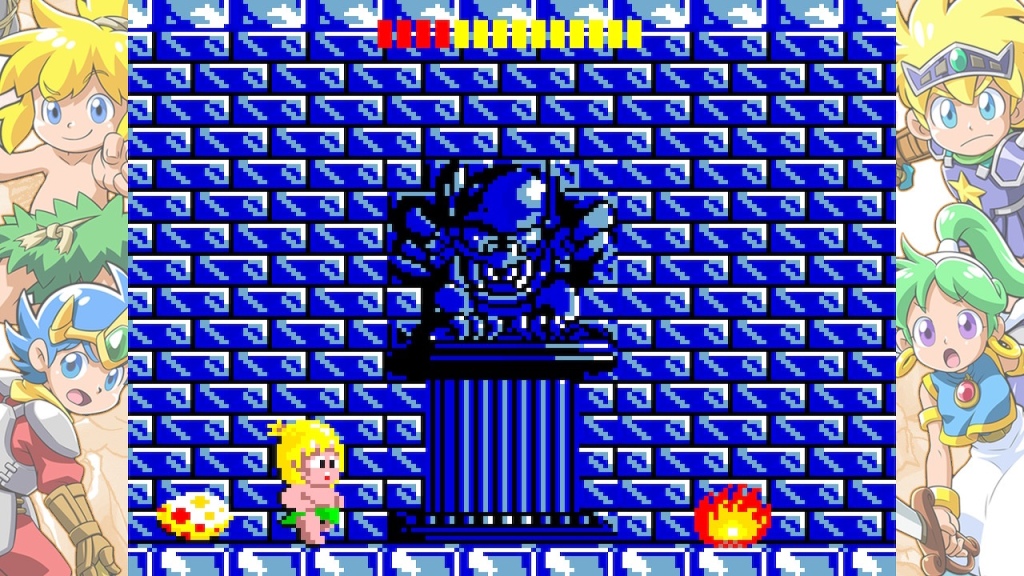
I’m sure it was a remarkable achievement at the time, but as far as this collection is concerned, this is the Master System version that we’ve just played twice but a bit blockier based on the tiny screen it’s being upscaled from, and don’t let the name fool you because I think we’re about to play again…
Revenge of Drancon – International / Western – Game Gear
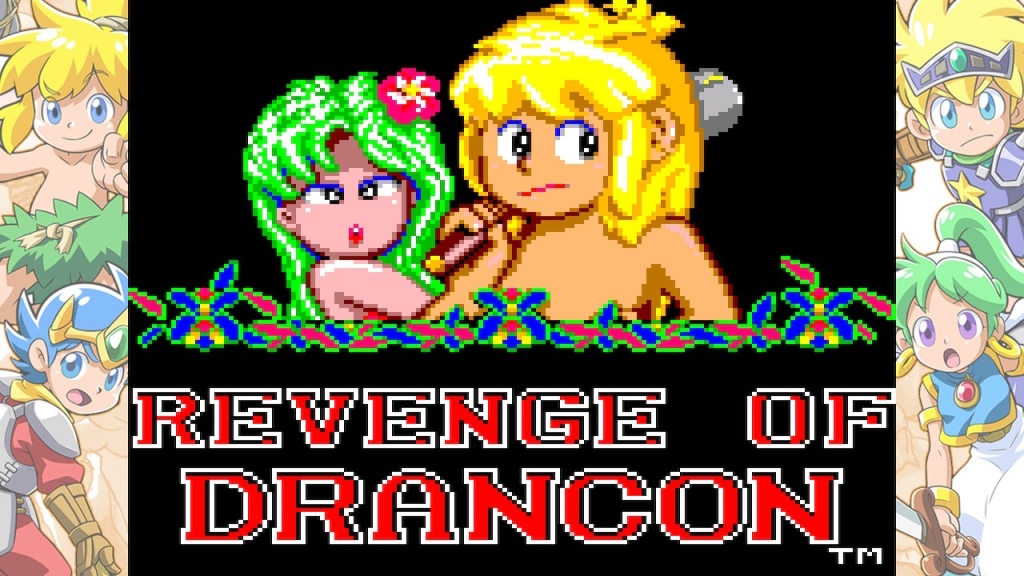
Revenge of Drancon. American for Wonder Boy. On the Game Gear. Again. Which means we’ve now had what’s effectively the same version of the game four times. Thank goodness for that crappy SG-1000 version to break things up! And don’t get me wrong, you’re getting one of the all-time great platform games and one of the all-time great conversions. Just a few times too many, in my opinion!
WONDER BOY IN MONSTER LAND
Wonder Boy in Monster Land – Japanese – Arcade (SYSTEM 2)

On to pastures new, then, with this 1987 arcade sequel that took the gameplay in a whole new direction, which, from my viewpoint, wasn’t a massively welcome one! Quite possibly the first ever action-RPG, it’s twelve linear levels of platforming and fighting and collecting coins to buy stuff and level it up, and it’s really good at what it does but it’s just not what I ever wanted Wonder Boy 2 to do! It’s set after the end of the first game, where the original evil ne’er do well has been replaced by a fire-breathing dragon who’s turned Wonder Land into Monster Land, and it’s up to Wonder Boy to stop it! Before we get on to how it plays, I do need to address the elephant in the room though, which is all the text you’d expect from a 1987 RPG, and this Japanese version really is the Japanese version this time, and to a non-Japanese speaker this makes actually playing the game a bit of a challenge, so maybe we should move on…
Wonder Boy in Monster Land – International / Western – Arcade (SYSTEM 2)
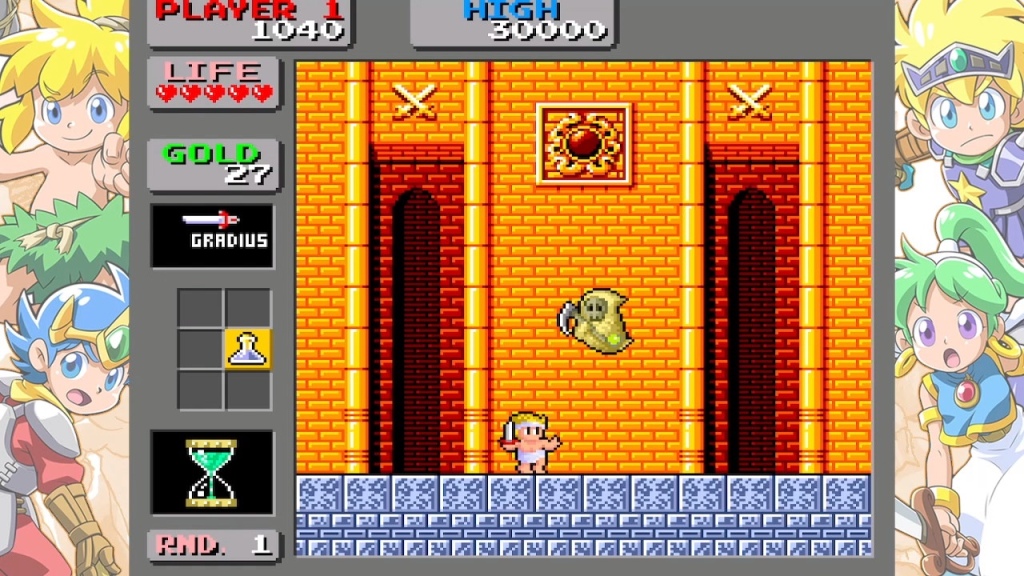
“Welcome to Monsterland, 10 gold get!” At least we’ve got the gist of all that text now! Same game, English (of sorts) text, good stuff. And while I’ll always be a bit down on this one for going all RPG and taking away the immediacy of the fun offered by the original, it’s actually really good! It starts out sedate, with lots of doors to open and people to meet and a few easy monsters to dispatch, but it soon ramps up as the platforming becomes more complex and there’s all sorts of secrets to find and bosses to take down. It ramps up the graphical vibrancy even further too, and the soundtrack is just superb. It does get a bit samey well before it’s done but you’ll have a great time until it does despite my ongoing negativity!
Wonder Boy in Monster Land – International / Western – Master System

This is where Wonder Boy naming started to go totally bonkers, with licensing issues over the Wonder Boy name leading to Bikkuriman World on PC-Engine and a whole new can of worms on top of the one Sega had already opened with Super Wonder Boy previously, but we’ll get to that version in a second! And I’m not going anywhere near the Saiyūki World version for the NES, which sparked a whole new parallel Wonder Boy universe that included the uniquely American Whomp ‘em! Some of the other ports of this one were proper stinkers too, but they picked the right version to include on this collection. It’s superb, from graphics and sound right down to being called what it was originally intended to be! It feels great to control, and there’s so much life and colour to everything. This game was always more suited to a home console than an arcade cabinet, and that makes it one of the greats on the system!
Super Wonder Boy: Monster Land – Japanese – Master System / Sega MARK III
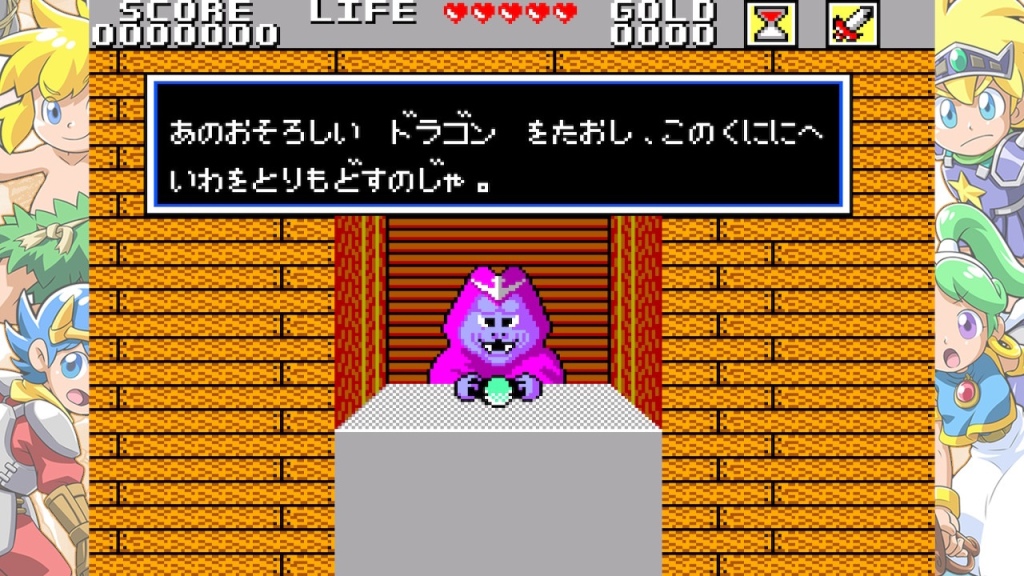
Same game, another name (and yet another one I’m sure they came to regret later), and obviously one for the Japanese-speaking audience but useless to the rest of us. And that’s it on this collection for the second Wonder Boy – the arcade version and the Master System in English and Japanese. All good!
WONDER BOY III: MONSTER LAIR
Wonder Boy III: Monster Lair – International / Western – Arcade (SYSTEM 16)
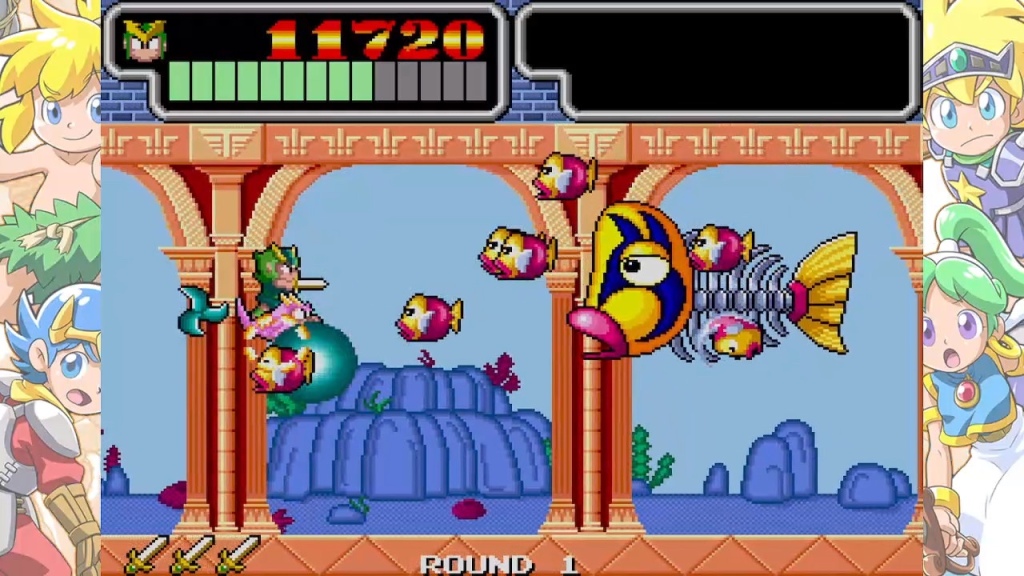
Just as the series was getting into its new RPG stride, along came 1988 with this strange auto-scrolling action-platformer meets horizontally scrolling shoot ‘em up! This was one or simultaneous two-player, with a totally nonsensical story about two young heroes hearing an old yarn about a boy called Book and being inspired to take up his fight, whatever it was. Each level is in two halves, starting with the automatic side-scrolling platforming and shooting stuff with various power-up projectiles, then switching to a pretty competent, albeit it unsophisticated and ultimately repetitive horizontal shooter before you take on some crazy boss or other. Nice comic art style with tons of imaginative colour, a jaunty soundtrack and some great sound effects, and it’s pretty fun to play for a while, though does get a bit tedious once you’ve got a bit good. Just wish the first bit auto-scrolled a bit quicker! Last arcade outing for Wonder Boy too.
Wonder Boy III: Monster Lair – International / Western – Mega Drive / Genesis

The graphics have been totally redrawn here to better suit the hardware but despite that, everything is familiar and it seems to be a really good port. Only two versions of this one here but I’ll gladly play either.
MONSTER WORLD II
Monster World II (Dragon’s Trap) – Japanese – Master System / Sega MARK III
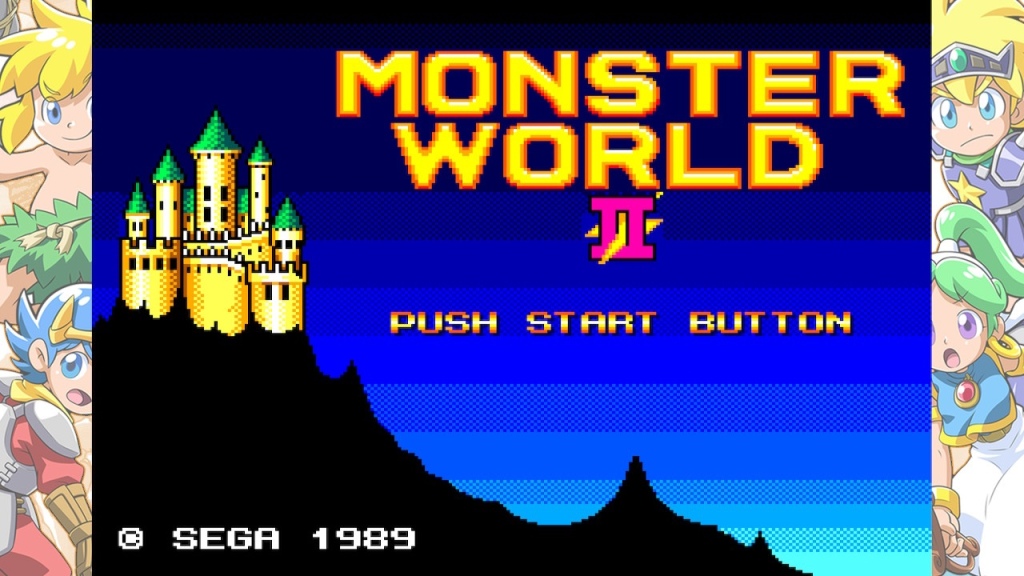
If things aren’t confusing enough already, hold on to your knickers… The game picks up straight after its predecessor, Wonder Boy in Monster Land (see!) and begins with a simplified play-through of the last level from that, where you’re in the Mecha Dragon’s lair. Turns out that after you killed it, you were cursed to become Lizard-Man, and now you’re on a quest to defeat a load more end of level dragons and rid yourself of the curse. We’re back to the RPG-lite formula again, but this time it was all designed from the ground up for the Master System in 1989. We’re also back to full-on Japanese text again too, so let’s skip ahead to the next version in the collection…
Wonder Boy III: The Dragon’s Trap – International / Western – Master System

Just want to point out it was their typo and not mine in the name! Yes, it’s another Wonder Boy III and apparently a typo is exactly what happened! Should have gone with Adventure Island like on the PC-Engine instead, although that’s not to be confused with the NES Adventure Island series… Right, it’s another top-notch Master System game and another top-notch Wonder Boy, full of polish and as much detail as the system would allow to bring life to the varied environments you’ll travel through. There’s a bit more depth to the RPG mechanics in this one too, and a bit more thought needed throughout, but it’s still addictive as hell and an impressive addition to the Master System library.
Monster World II: The Dragon’s Trap – Japanese – Game Gear
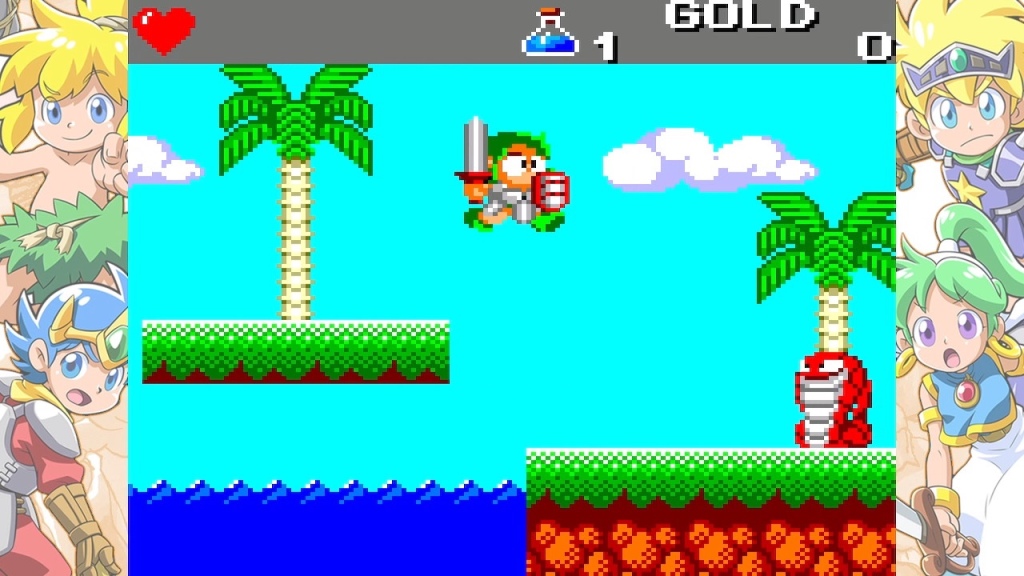
Arrived in 1992 but today is a chunkier version of the one I couldn’t understand above, so let’s move on…
Wonder Boy: The Dragon’s Trap – International / Western – Game Gear
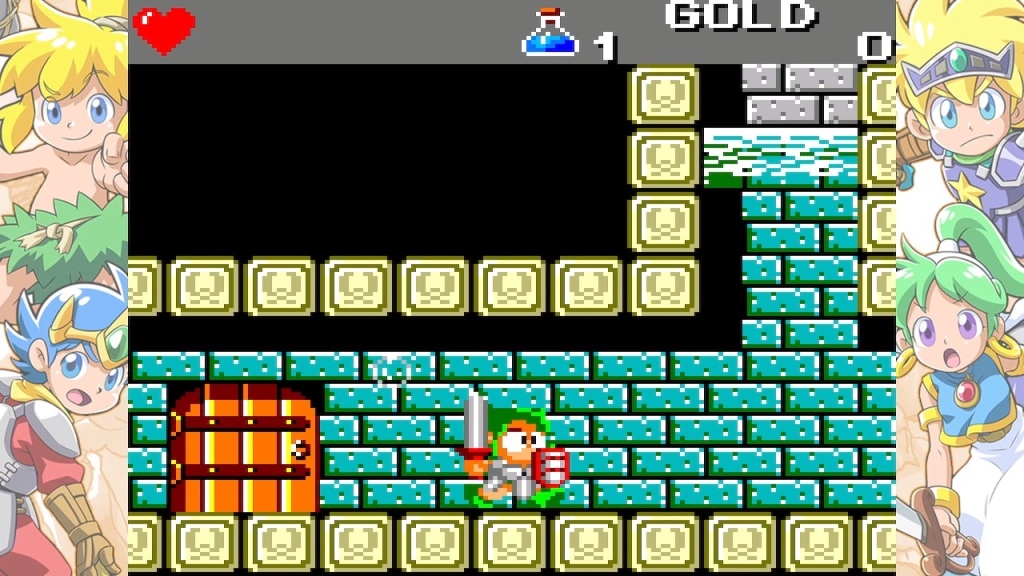
Good name! Wonder where it fits into the Wonder Boy mythos though? Anyway, it’s a chunkier version of the one I just enjoyed above, and at the same time is more in your face and frantic as a result, and I kind of like that, especially playing handheld on the Switch as was originally intended for this one. I didn’t mention the soundtrack before either – performing miracles with the Game Gear’s little voice. Once again, we can question the necessity for four versions of what’s effectively the same thing, but they’re all here so take your pick!
MONSTER WORLD III
Wonder Boy V: Monster World III – Japanese – Mega Drive
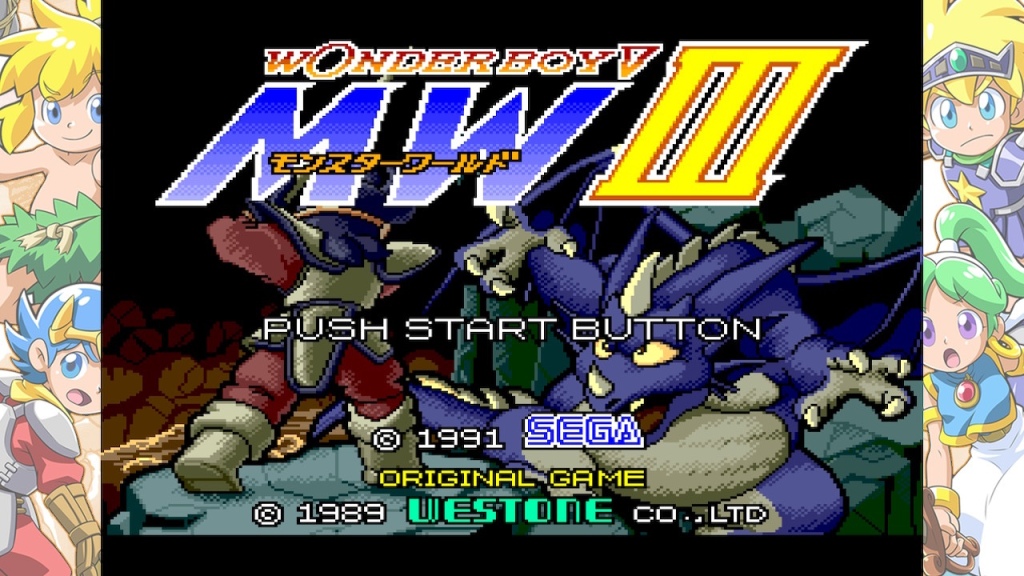
Just when you thought you might have seen this name before, along comes the lead Japanese version from 1991 to set the record straight – it’s the fifth Wonder Boy game and the third in its Monster World subset. So there! It was simply called The Dynastic Hero on PC-Engine though, and had a different plot, in case you were worried about any sense about to emerge though! The plot in this version is the peaceful (really?) land of Monster World has been invaded by monsters, the Princess has been kidnapped, and you’ve got to sort it out. And we’ll do exactly that when we get our hands on the English version…
Wonder Boy in Monster World – International / Western – Mega Drive / Genesis
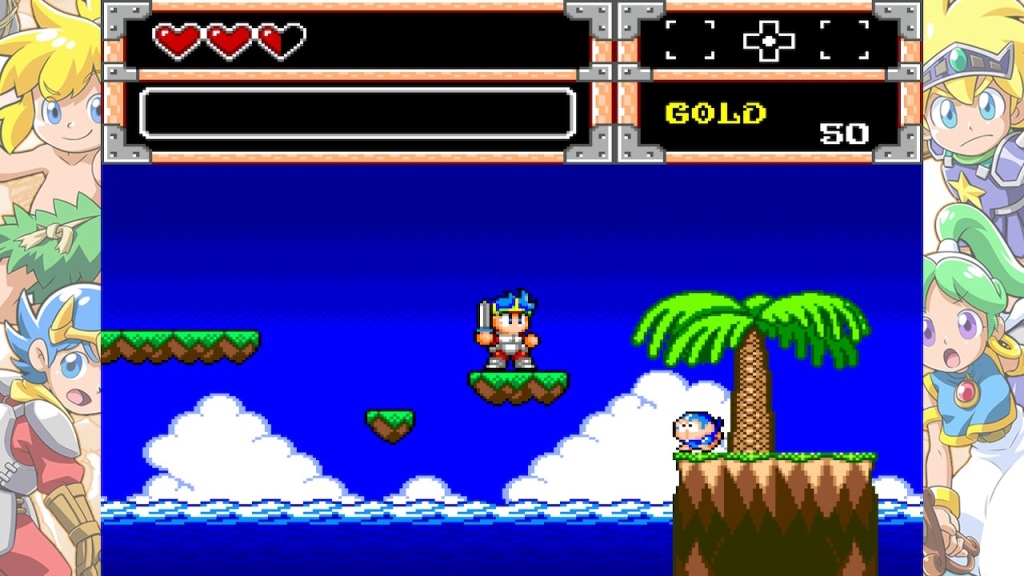
Right, here we are, and it’s more of the same platforming-RPG action we’ve come to know and, er, accept. As you’d expect on new-fangled 16-bit hardware, this thing is a looker (and a sounder) and is quite the size too! The scrolling is a little choppy, but you do adjust to that and some cool parallax effects do make up for it, and there’s some lovely animation and that trademark mass of colour has never been brighter. The RPG systems are deeper too, and it’s all feeling more Zelda than original Wonder Boy, but there’s so much to sink your teeth into that you’re unlikely to be pining for a bit more leaping about now you’re here! Worth noting that this version got a bit of save-game “balancing” for the Western audience, but unless you speak Japanese you’ll never tell the difference! More than ever to explore here, and you’ll have a great time doing so.
Wonder Boy in Monster World – International / Western – Master System / Sega MARK III
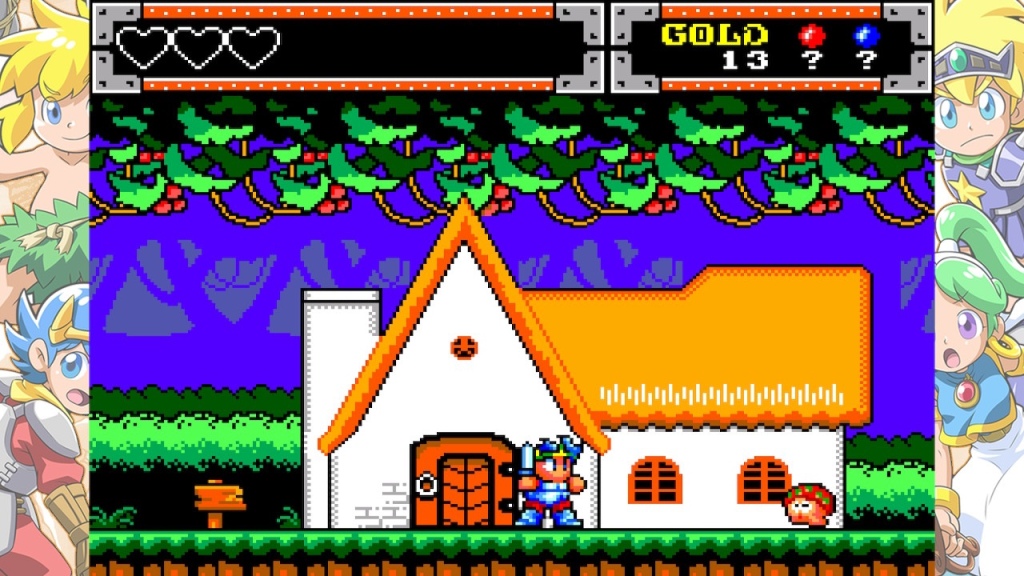
This version was actually released three years after its Mega Drive or Genesis counterpart in 1994, and developed specifically for the European market. And unfortunately this version is the first thing on here I don’t like (rather than simply question its presence) since that SG-1000 monstrosity! Firstly, it looks like it was made for five year olds. Obviously, the graphics were necessarily redrawn for the Master System, but rather than try and get the best out of it, it’s like they’ve tried to do Mega Drive on the Master System, with big sprites and big scenery with too much colour that come across more condescending than cute. Maybe that’s just me though, but what’s not just me is my second complaint – swing your sword while you’re moving and you come to a jarring halt. It’s horrible to control as a result. The soundtrack is lovely on the plus side, and I’m sure it was great getting this if you were still a Master System owner so many years after the fact, but there’s no need to play this today, especially when it’s 16-bit counterpart is just a menu button press away.
MONSTER WORLD IV
Monster World IV – Japanese – Mega Drive
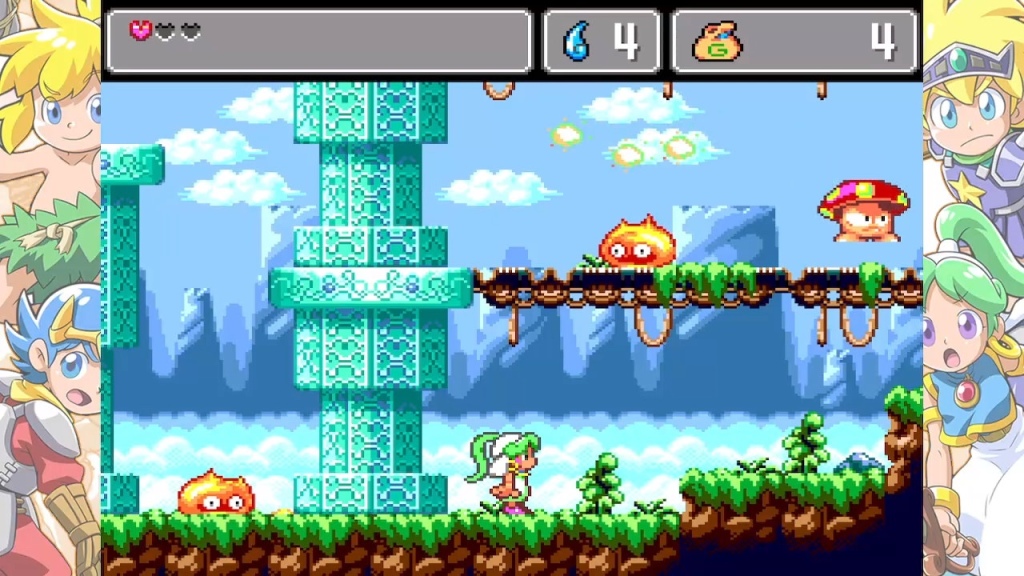
A very long time ago, I said I’d probably be stealing some of the description text that comes with each game’s menu screen. Now we’re at the end I’ve finally remembered to do so too, and to celebrate I’m going to nick the full works! “In early 1994, the 6th and last part of the original Wonder Boy series was released and dropped the “Wonder Boy” title, because a female main character named Asha was the star of the game – to the surprise of many fans! This time the Monster World introduced an arabic-style setting that may as well be found in the Tales of One Thousand and One Nights. With genies, mages and little fur balls callled Pepelogoos.” And now I’ve filled this space, let’s jump to the English version of the same game!
Monster World IV – International / Western – Mega Drive / Genesis
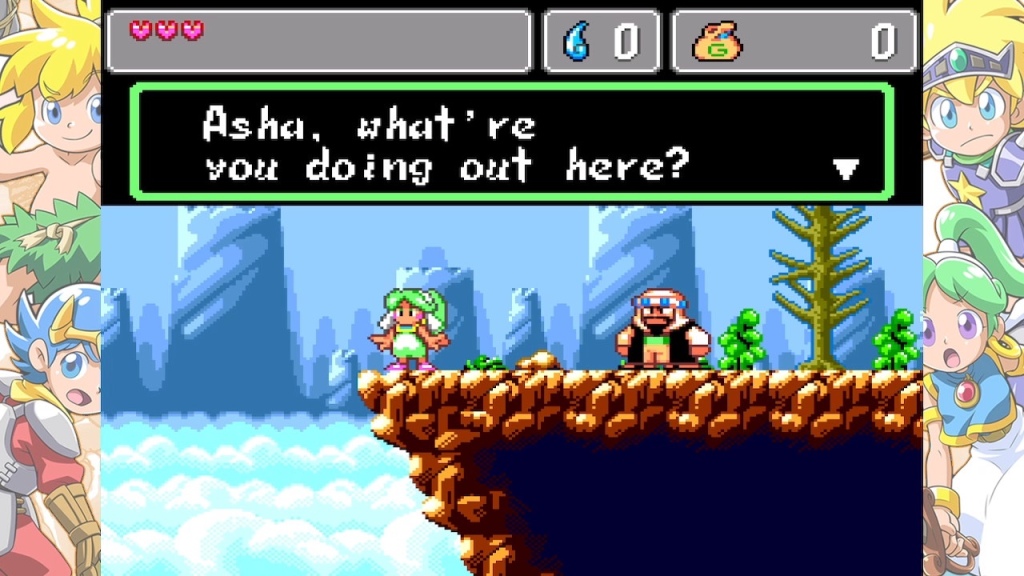
I love this game – and I’m talking in my list of all-time favourite games kind of love like the first Wonder Boy – from the Star Wars text scroll in the attract mode to some of the most beautiful sights you’ll ever see in a 16-bit game way further down the line! And to think it only exists in this form because of a 2002 fan translation! The series has now fully morphed into a side-scrolling action-JRPG, although it is a bit more focussed in scope than the last couple of entries; maybe a bit easier too, but that’s to its benefit. As are the far more refined RPG systems, and the relative lateness in the console’s life, which allows all the stops to be pulled out for a visually stunning experience, full of diversity and life, and the soundtrack is just a thing of beauty on top. Wonder Boy might not have been Wonder Boy by this point, but it’s exactly where it needed to bow out. And just like its very original predecessor and the game we started with here, it’s a masterpiece.
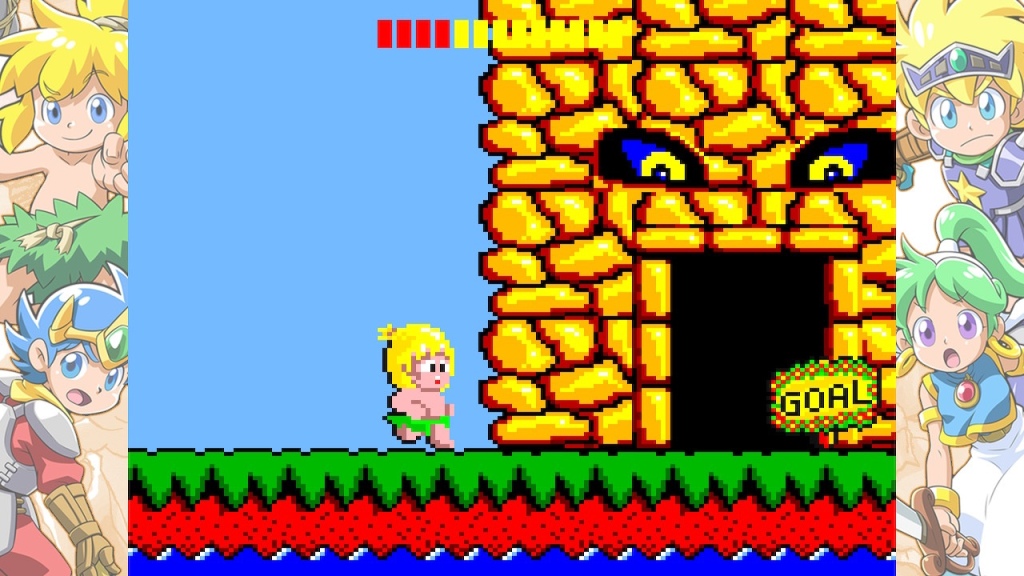
And on that delightful bombshell, our work here is done, except for the small task of drawing some conclusions… For starters, whatever your favourite version, you have those two masterpieces plus four other wonderful experiences here in some shape or form depending on your preference. And in some cases you’ll no doubt want to play more than one. Next to think about, then, is if you own any other Wonder Boy collection, digital or physical, released in the last year, do you need this one too? And the answer is a resounding no. Likewise, do you need twenty-one versions of six Wonder Boy games? Again, absolutely not. Which then begs the question is it worth £44.99 regardless? Well, the thing is, the aforementioned Wonder Boy Collection is still available, and it’s £24.99. Which you could also justifiably question the value of, but anyway, the next question here, then, should be is the addition of Wonder Boy III: Monster Lair and Wonder Boy: The Dragon’s Trap (or whatever you want to call them), together with their extra versions, then worth the additional £20. And you already know the answer!

